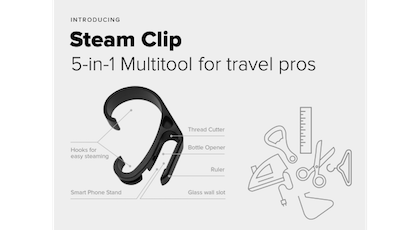If you’re gearing up for the launch of a new Kickstarter or Indiegogo campaign, you’re gonna want to have a healthy email list that is ready to buy on day 1!
As I stated in my book, the Kickstarter Launch Formula, email is the #1 sales channel for online businesses. It’s the easiest way that you can drive sales in the first week of your campaign.
There are many ways that you can go about building your email list before you do a product launch. Today, I’m going to hone in one one strategy… how to set up a landing page!
A landing page is optimized to capture the email address of a website visitor. The effectiveness of the landing page is gauged on how well it “converts,” meaning the number of website visitors that convert into active email subscribers.
By sending a potential customer to a landing page, you ensure that they won’t be distracted by all of the links on your website. They can only do one of two things:
- Opt-in to your email list
- Close the browser window
The software tools that I’m about to mention will help you set up a landing page with minimal hassle so that you can start getting email subscribers.
1. Leadpages
Leadpages is the software tool that I use to manage my various landing pages. I used it to give away the FREE video in the Kickstarter Launch Formula. I also use it for KickstarterForum.
While not the only tool out there, it was one of the first to really make it on the scene. It’s dead simple to use the drag-and-drop editor or customize one of the templates and start collecting email addresses.
You can create A|B tests to see how different messages perform. You’ll also get critical analytics regarding how many people are visiting the landing page and how many are converting into email subscribers.
To help you out, I’ve put together a free training video that will quickly get you up to speed. I’ve embedded it below.
As you might assume, there are also lots of integrations like MailChimp, Buffer, Salesforce, and more. I like Leadpages and am an affiliate for them.
Pricing ranges from $25/month to $199/month when paid annually.
2. Instapage
Instapage is another software tool that you can use to set up a landing page and start building your email list.
When I was first looking into Instapage, I really liked it’s drag and drop interface, which was superior to Leadpages. Since then, Leadpages has integrated more drag and drop functionality with some free themes.
Similar to Leadpages, Instapage offers a lot of analytics, integrations, themes, and functionality like count down timers.
In terms of the full control of customizing a page and design, I think Instagram beats Leadpages, but you might disagree with me!
The pricing ranges from $29/month to $127/month when paid annually.
3. Launchrock
Believe it or not, Launchrock is what I used when I set up my very first tech startup called MusicMind. It’s super easy to set up a simple landing page to collect email addresses.
I gotta admit that Launchrock is not as powerful of a solution as the above two, but it certainly does hold its weight. There are a lot of beautiful templates that you can choose from including:
- Retail
- Saas
- Mobile
- Product pre-order
After you choose your category and theme, you can start collecting email addresses. You’ll get valuable data that you can use to turn more website visitors into email subscribers.
4. Unbounce
Unbounce was founded in 2009 and is a robust software solution to set up landing pages and A|B test messages with your website visitors.
When you sign up for the service, you’ll gain access to:
- Drag and drop builders
- 125+ high converting templates
- Dynamic text replacement
- Video widgets
- Lightboxes and more.
Unbounce was founded before many of the other solutions. Ironically, I used this for my second tech startup, which ended up not working out. I learned some really important lessons though.
Pricing for Unbounce ranges between $49/month and $499/month.
5. Thrive Leads
If you want to use WordPress rather than another bit of software, you can look into a plugin like Thrive Leads.
Thrive Leads gives you most of the functionality as the above options, including:
- A|B Testing
- Popup Lightboxes
- Reporting and analytics
- Multiple-choice forms
- Content lock and more.
The software also integrates with many of your other solutions, like MailChimp.
Pricing ranges between $19/month paid annually or a one-time single license of $67.
P.S. I recommend setting up a WordPress website using this hosting provider, because they’re awesome. I use them to host all my sites!
6. OptimizePress
The last landing page solution that I’ll be mentioning in this list is OptimizePress. I used to use this software to set up landing pages, sales pages, and membership websites.
No doubt, it’s rich with functionality. The templates are beautifully designed. It looks very professional.
If you’re looking to become a professional marketer, this is a great solution for you in the long run.
However, for me, there were a few downsides. There’s a bit of a learning curve in terms of figuring out how to use the software. You’ll also be hosting the software on your own WordPress website. This means that you must deal with all of the technical issues, should they arise.
I wouldn’t recommend it for a beginner, but it’s a great solution if you know what you’re doing.
Pricing: $97
Which should you choose?
If you’re going to ease-of-use, I’d look into the top three in the list. If you want something that’s hosted on WordPress, check into the last two. At the time of writing, I’m still using Leadpages.
Your next step after setting up a landing page is to send it traffic and measure your conversions. You’ll be able to hone your message, improve your marketing, and get even more email subscribers.
Believe me, this will all pay off when you launch your upcoming product!










